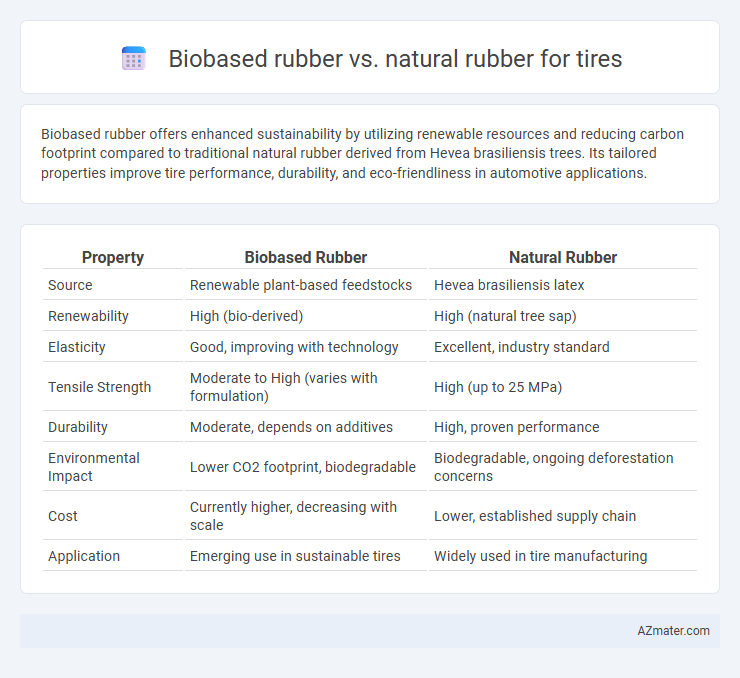Biobased rubber offers enhanced sustainability by utilizing renewable resources and reducing carbon footprint compared to traditional natural rubber derived from Hevea brasiliensis trees. Its tailored properties improve tire performance, durability, and eco-friendliness in automotive applications.
Table of Comparison
| Property | Biobased Rubber | Natural Rubber |
|---|---|---|
| Source | Renewable plant-based feedstocks | Hevea brasiliensis latex |
| Renewability | High (bio-derived) | High (natural tree sap) |
| Elasticity | Good, improving with technology | Excellent, industry standard |
| Tensile Strength | Moderate to High (varies with formulation) | High (up to 25 MPa) |
| Durability | Moderate, depends on additives | High, proven performance |
| Environmental Impact | Lower CO2 footprint, biodegradable | Biodegradable, ongoing deforestation concerns |
| Cost | Currently higher, decreasing with scale | Lower, established supply chain |
| Application | Emerging use in sustainable tires | Widely used in tire manufacturing |
Introduction to Biobased and Natural Rubber in Tires
Biobased rubber, derived from renewable plant sources such as guayule and dandelion, offers a sustainable alternative to traditional natural rubber harvested from Hevea brasiliensis trees. Natural rubber is prized for its elasticity, durability, and resilience, making it essential in tire manufacturing for maintaining grip and performance under varying conditions. Advances in biobased rubber focus on matching the mechanical properties of natural rubber while reducing environmental impact and dependency on tropical rubber plantations.
Source Materials: Origins of Biobased vs Natural Rubber
Biobased rubber is derived from renewable resources such as plant oils, agricultural byproducts, or synthetic polymers partially sourced from biological materials, offering sustainable alternatives to traditional rubbers. Natural rubber originates primarily from the latex sap of Hevea brasiliensis trees, harvested mainly in Southeast Asia, providing high elasticity and resilience. The key difference lies in biobased rubber's potential to reduce dependency on natural rubber plantations while utilizing diverse biomass feedstocks for production.
Environmental Impact: Sustainability and Ecological Footprint
Biobased rubber offers a significant reduction in carbon footprint compared to natural rubber, as it is derived from renewable biomass sources that require less intensive land use and generate lower greenhouse gas emissions. The sustainable production of biobased rubber minimizes deforestation and biodiversity loss often associated with natural rubber plantations, promoting ecological balance. Its biodegradability and compatibility with circular economy initiatives further enhance environmental benefits, making it a more sustainable alternative in tire manufacturing.
Performance Characteristics in Tire Applications
Biobased rubber and natural rubber both exhibit excellent elasticity and abrasion resistance crucial for tire performance, yet biobased rubber often offers enhanced sustainability without compromising durability. Natural rubber is renowned for its superior tensile strength and resilience, which contributes to better traction and wear resistance in tires. In tire applications, biobased rubber formulations are increasingly engineered to match or exceed natural rubber's performance characteristics, including wet grip and fuel efficiency, making them viable alternatives in eco-friendly tire manufacturing.
Durability and Longevity: A Comparative Analysis
Biobased rubber offers enhanced durability with improved resistance to abrasion and cracking compared to natural rubber, which often suffers from faster degradation under harsh environmental conditions. The molecular structure of biobased rubber incorporates synthetic polymers that enhance flexibility and tensile strength, resulting in extended tire longevity. Studies indicate that tires made with biobased rubber demonstrate up to 30% longer tread life and superior wear resistance than traditional natural rubber tires.
Manufacturing Processes and Industrial Scalability
Biobased rubber production integrates renewable biomass feedstocks like plant oils and microbial fermentation, leveraging advanced biotechnologies to create sustainable elastomers with potential for lower environmental impact than traditional natural rubber derived from Hevea brasiliensis latex. Manufacturing processes for biobased rubber often utilize chemical modification or polymerization techniques compatible with existing tire production lines, enabling partial substitution without sacrificing performance or requiring significant capital investment. Industrial scalability of biobased rubber remains challenged by feedstock availability and cost-efficiency, but ongoing developments in synthetic biology and agricultural biomass valorization are rapidly enhancing volume production potential to meet automotive industry standards.
Cost Comparison: Biobased vs Natural Rubber Tires
Biobased rubber tires often have higher initial production costs compared to natural rubber tires due to the complexity of sustainable extraction and processing methods. Natural rubber remains more cost-effective because of established supply chains and large-scale cultivation in tropical regions, leading to lower raw material prices. However, advancements in biobased rubber technology and increasing demand for eco-friendly products are gradually narrowing the cost gap between these two materials in tire manufacturing.
Market Adoption and Industry Trends
Biobased rubber is gaining traction in the tire industry due to increasing demand for sustainable and eco-friendly materials, driven by stringent environmental regulations and consumer preferences. Natural rubber remains dominant because of its superior performance characteristics and established supply chains, but price volatility and land use concerns are encouraging manufacturers to explore biobased alternatives. Industry trends show collaborations between tire manufacturers and biotech companies to enhance biobased rubber production scalability and optimize material properties for tire performance.
Regulatory and Certification Considerations
Biobased rubber for tires must comply with evolving international standards such as ISO 18265 for natural rubber and additional certifications like USDA BioPreferred to validate its renewable content. Regulatory bodies emphasize strict adherence to environmental impact assessments and lifecycle analysis to ensure sustainability claims meet criteria under frameworks like the EU's REACH and the US EPA. Certification processes also involve testing for durability and performance equivalence to natural rubber to satisfy both safety regulations and market acceptance in the automotive industry.
Future Outlook: Innovations in Sustainable Tire Materials
Biobased rubber is gaining momentum as a sustainable alternative to natural rubber in tire manufacturing, driven by advancements in polymer chemistry and green extraction techniques. Innovations such as genetically engineered plants producing high-yield biobased latex and the integration of biodegradable fillers enhance the environmental profile of biobased tires without compromising performance. The future of sustainable tire materials hinges on scalable biobased solutions that reduce dependency on traditional rubber plantations, lower carbon footprints, and improve recyclability within the tire lifecycle.

Infographic: Biobased rubber vs Natural rubber for Tire
 azmater.com
azmater.com